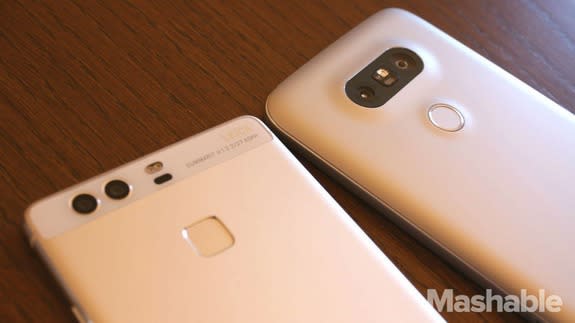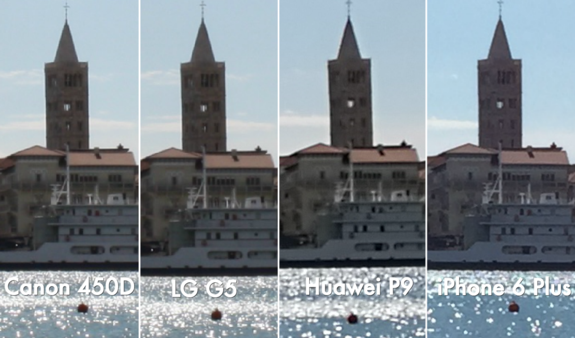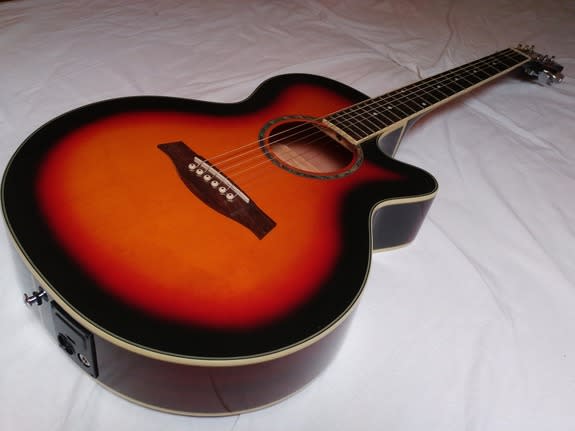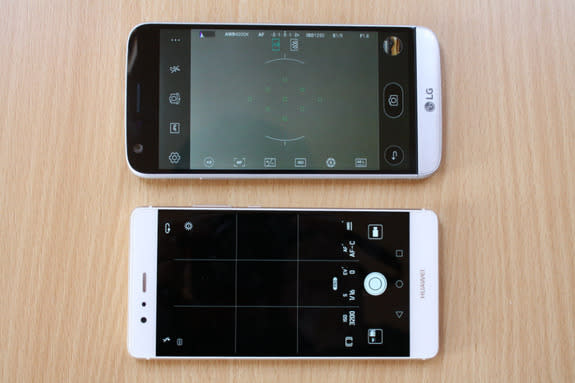Huawei P9 vs. LG G5: Which dual-camera phone takes better photos?

How do you improve a smartphone camera? The easiest way would be to use a faster lens and larger sensor. But with today's super slim smartphones, you can't just slap a huge camera module on the back — unless you want it to have an unsightly bulge.
One solution seems to be the trend in 2016: multiple cameras. That, at least, is how several smartphone heavyweights, including LG and Huawei, are tackling the matter. And with rumors that Apple's iPhone 7 might come with two rear-facing cameras, it's a good time to look evaluate if two cameras are better than one.
See also: 16 apps that will seriously raise your Instagram game
I spent the last week with two dual-camera flagships: The LG G5 (read Mashable's review here) and the Huawei P9 (full review coming soon). Both companies tout the camera features heavily in their promotional materials, especially Huawei, which says the P9 will "reinvent smartphone photography." But even though both phones have two cameras on the back (and an 8-megapixel one on the front, so three in total), they are built with very different approaches and, as a result, often take very different photos.
One is not like the other
The LG G5 has one 16-megapixel sensor on the back, which, for the most part, is the phone's main camera. The 135-degree, 8-megapixel sensor next to it kicks in when you zoom out to capture a very wide, slightly distorted (fish-eye effect) photo. But the main sensor is better in all regards, and photos are better with the ultra-wide option turned off.
The Huawei P9 has a different approach. A collaboration between Huawei and Leica (explained in detail here), the phone's two sensors take photos together, with one specializing in monochrome (black and white) photos. Huawei's software then merges the two images into one, which should (ideally) result in a lot more detail.

Image: Stan Schroeder/Mashable
Spec-wise, the LG G5's main sensor has 16 megapixels, with an f/1.8 aperture and optical image stabilization. The Huawei P9 has two 12-megapixel sensors, with f/2.2 aperture and no optical image stabilization — so, a step or two behind LG in every department, at least on paper. The 12-megapixel sensors do have a large, 1.25µm pixel size, which should ideally result in them capturing more light than the cameras on most phones. (I could not find the LG G5's camera pixel size, but for comparison, the iPhone 6S Plus' camera sensor has a 1.22µm pixel size.)
Both phones' cameras are set to "auto" mode by default, but can also be set to "pro" mode, which offers a lot of camera settings, including shutter speed, white balance, ISO sensitivity and the like. On top of that, both devices (especially the Huawei P9) have a ton of different extra scene modes, including night mode, High Dynamic Range (HDR), panorama, beauty (for selfies) and more. Both phones also have have 10 "film modes" (Instagram-style filters) that mimic the look of old film. And if you're really interested in shooting in pro mode, both phones can take RAW format photos, the standard for professional photography.
See also: The search for the ultimate smartphone camera
All these features leave us in a conundrum: How do you make sure the comparisons are fair? Three approaches make sense. One is to fiddle with the settings and try to make the absolute best photos on each phone. The other is to have both phones set on exactly the same settings, and compare resulting photos. I went with a third option: I took most of the photos on auto mode, for several reasons.
Firstly, this is how most people use their smartphone camera. Secondly, it's hard to have both phones on the same settings. For example, the LG G5 does not have an option to set image size. You can change the aspect ratio from 1:1 to 4:3 to 16:9, but you can't actually force the camera to take a 9- , 12- or 16-megapixel photo.
With that in mind, let's dive into the comparisons!
Outdoors (daylight)
I was lucky to have absolutely beautiful, sunny outdoor conditions — where smartphone cameras shine — on several of my testing days. I expected the LG G5 to have a slight edge with its better camera specs, but I was interested to see what the Huawei P9's dual-camera approach could do for sharpness and details.
In the first example, the Huawei P9 took a beautiful, clear photo, with tons of detail, though the colors were a bit too vivid. The LG G5's photo has more accurate colors, and is overall very good, but the Huawei P9 wins on sharpness and details.


In the second example, the Huawei P9's photo is sharper, but overall the two photos were very similar.


A more thorough comparison revealed the LG G5 was the clear winner, though. To highlight this, I took a photo of the same scene with a 12-megapixel Canon 450D DSLR, and an iPhone 6 Plus. Below, you can see zoomed-in crops from each camera. The LG G5 is comparable to the Canon 450D, though both could stand to be a bit sharper. The Huawei P9 strikes a good balance between sharpness and details, but if I had to choose one for posterity, it'd definitely be the photo taken by the LG G5.
To show how the dual-camera phones fare versus a "standard" smartphone, I included a photo from the iPhone 6 Plus. It took the best photo, but only if you look at it on the phone's screen. Zoom in, and you'll see a lot of unnatural sharpening, with the iPhone's post-processing algorithms doing way too much to make the photo appear nicer. Considering the iPhone 6 Plus only has an 8-megapixel camera, it does a pretty good job overall.

Image: Stan Schroeder/Mashable
Winner: Draw
Outdoors (low light)
Both phones had problems with the evening scene I chose, not only due to the low light conditions, but also due to the artificial light source in the foreground. Here, the Huawei P9 struggled since it lacks optical image stabilization; it took more tries to take a sharp photo with it than with the LG G5. As a result, the Huawei P9's photo is darker, blurrier and grainier. Zooming in reveals that the Huawei P9 uses far less artificial post-processing to enhance the image. This round goes to the LG G5.


Winner: LG G5
Indoors
In a low-light, indoors scenario, the LG G5 fared better. Again, likely due to its optical image stabilization and larger aperture. The Huawei P9's photo had a slight yellow tint, and was considerably blurrier.


Winner: LG G5
Superpowers
With such a big difference between these phone cameras, I decided to highlight one of each's biggest strengths; superpowers, if you will. The Huawei P9's superpower is its monochrome mode. With one camera dedicated solely to capturing details in black and white, I predicted the Huawei P9 would perform better.
And that it did. The Huawei P9 destroyed the LG G5, taking a slightly darker, but otherwise flawless photo, even at a lower resolution. The LG G5's photo (taken with one of the film filters) wasn't truly monochrome, but more like a desaturated image. It's good-looking for a black and white shot, but the Huawei P9's pure monochrome shot is better in every regard, especially when you zoom in and look at the details.


A closer look at the details from the same two photos is below. I also tried desaturating a regular color photo taken with the LG G5 to make sure the film filter was not wreaking havoc on the photo quality, but the results were nearly identical.

The Huawei P9's monochrome camera lets you do another neat trick: If you shoot in aperture-mode, you can change the image focus after you take the photo. We've seen the trick before, and while it does look cool in certain situations, I reckon few people will use it regularly.
The LG G5's ultra-wide camera has the advantage of letting you take a group photo of 10 people standing a few feet in front of you without needing to move farther back. You can't do that with any other phone and it's really really useful when you need to fit more into a shot. As you can see below, the difference is staggering.


There's a slight caveat to the LG G5's ultra-wide mode. If you accidentally move the zoom slider down from its default setting just a little, you won't see a big difference on the phone's screen, but the phone will take 8-megapixel photos which are far, far worse than the ones taken by the main, 16-megapixel camera. It happened to me on my first test; it took me half a day to figure out why the LG G5's photos weren't as sharp. The LG G5's software mitigates this by giving you two icons to switch from one camera to the other, but if you're zooming manually, with your fingers, make sure you're aware of which mode you're in.
Winner: Draw
UI, speed and other details
LG and Huawei crammed a lot of features in their camera UI. But as packed as the camera apps are, they're pretty accessible. Both companies tackled the problem in a similar way — once you choose the auto mode of operation, most features get out of the way. However, the Huawei P9 lets you access the settings by sliding your finger up, left or right and when you go manual, while the LG G5 has them hidden behind buttons on top. Both approaches have their drawbacks; I prefer the look of Huawei's UI but I had no trouble getting used to either one.

Image: Stan Schroeder/Mashable
Flip the phones around and the Huawei P9 suddenly looks much better than the LG G5. Its two camera sensors sit flush with the phone's back, looking quite elegant. The LG G5's camera modules are lodged inside a pretty wide (though not very tall) bulge — not a big deal, but definitely not as pretty as on the Huawei P9.

Image: Stan Schroeder/Mashable
The Huawei P9 also shares a feature with other Huawei phones that I love: You can take a photo by tapping on the fingerprint scanner on the phone's back. The LG G5 has no such option, so you're stuck either clicking the volume buttons or tapping on the screen to take a photo.
When it comes to speed, both phones' cameras are very fast to start up and take a photo, though you'll have to wait a little longer for the Huawei P9 in low-light scenarios. Furthermore, the LG G5's autofocus is a little snappier. On the other hand, the Huawei P9 has a super-speedy way to take a photo: Tap twice on the lower volume button, even if the phone is locked, and you'll take a photo in about a second total. The LG G5 has the same feature, but it just brings you to the camera, without taking a photo.
Winner: Huawei P9, by a small margin
Final verdict:
There's a lot I didn't cover — videos and selfies come to mind — since I wanted to focus on what's different about these two phones, and that was the dual-camera setup on the back. It just goes to show how advanced smartphone cameras are these days; with each phone, you get a small video/photo studio with vast potential, even with all the limitations of a tiny camera module.
If we just look at the dual cameras on the back of these devices, there's still no clear winner here. Both phones have a lot to offer: The LG G5's ultra-wide mode is an amazing feature (as long as you're careful not to turn it on accidentally) which no other phone has. It, however, does little to improve the quality of the "regular" photos you'll take. Huawei's approach also has tremendous benefits. In some scenarios, the Huawei P9 takes better photos than any other smartphone out there. But the Huawei P9 has its limitations; the 12-megapixel sensor and the lack of optical image stabilization both drag it down somewhat.
Even with those drawbacks, the Huawei P9 has one of the best cameras on the smartphone market, and the next iteration of its dual-camera concept could really do wonders for smartphone photography.
Winner: Draw

